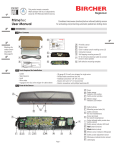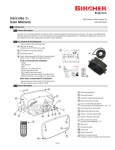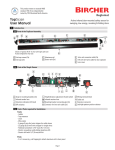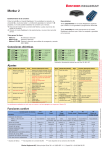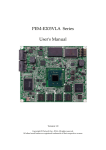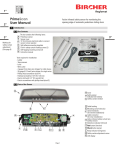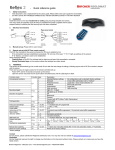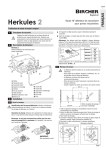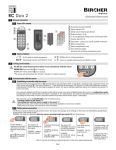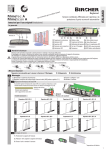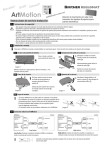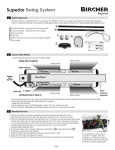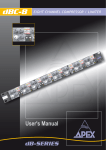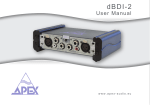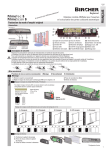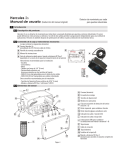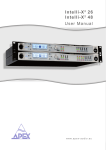Download Hercules 2 - Bircher Reglomat
Transcript
EN ISO 9001 Quality Herkules 2 international level Microwave motion detector for industrial doors Translation of the original operation instruction 4 Safety instructions 1 The unit may only be operated from a protection low-voltage system with electrical separation. The unit may only be opened and repaired by the supplier. Never touch any electronic components of the detector 5 If the device is already connected, interrupt the power supply for 5 seconds. After mounting, activate the wide field with the remote control (B+1). Addressing: Each detector can be assigned an address (1–4 with DIP switch and 5–7 with remote control). Different addresses are necessary when several detectors are within the range of a remote control. Description of the detector 2 Adress 1* Herkules 2 Microwave motion detector for industrial doors * Factory setting Adress 2 Adress 3 3 Adress 4 7 Other addresses 5, 6 + 7 can be set using the remote control (F+8+5…7) TOP 5 1 8 3.2 Mechanical mounting 12 13 – The detector must be firmly mounted on a flat surface. (Avoid vibrations) – Objects such as plants, flags, fans etc. must not protrude into the detection area. – The detector must not be obscured by covers/signs – Fluorescent lamps should not be placed in the immediate vicinity of the detection area – Mount the device in the middle above the industrial door 14 5 TOP 4 10 15 11 6 2 9 2 3 4 5 6 7 8 9 55 (2.17") Housing Front cover Rear wall Mounting bracket Fastening Cover screws 8-pin cable Microwave planar module Screw terminal 10 11 12 13 14 15 Key X Key Y Switch addressing LED red LED green Clip Before Mounting 3.1 Use the drilling jig enclosed in the packaging! 73.5 (2.89") Mounting 3 2") (0. 5 Ø 13.5 (0.53") 1 Field geometry: Select whether a narrow or wide field geometry should be used. The clip must be used for the wide field. Note:The clip can be used for mounting heights up to max. 4 m. It is not mounted on delivery. (However, it is stuck onto the rear of the antenna.) 1. Affix drilling jig to wall or ceiling and drill holes according to values given. 2. Route cable through opening provided in mounting bracket and make sure length is sufficient for wiring. 3. Screw mounting bracket on tightly 4. Hook detector into mounting bracket and set detector to required angle. Standard angle: 30° 5. Connect cable according to type plate. Ceiling mounting: Wall mounting: 125 min. 50 50 125 50 2 125 41 1 41 IMPORTANT: Fit the clip correctly! 3 45 125 min. 50 45 Page 1 Configuration mode can only be activated with the remote control if a code has been stored previously (see access code). Electrical connections 3.3 white 12–28 V AC / 12–36 V DC 1. Press start key G ➔ G and one of the keys 1...7 light up brown 12–28 V AC / 12–36 V DC green yellow grey pink blue red Relay 1 48 V AC / DC 55 VA / 24 W 2. Press C then 9 ➔ C and 1 light up ➔ Access code function is switched on Relay 2 48 V AC / DC 55 VA / 24 W 4 Settings 4.1 Switching on and factory setting 3. Enter four-digit code 1111 - 9998 4. Press C ➔ C and 1 light up ➔ Configuration mode is activated ➔ Detector is ready for programming ➔ If C and 2 light up, code was incorrect ➔ Start again from step 1 After the supply voltage has been connected, the red LED signals "Start-up" by flashing. The factory setting is suitable for the following applications: – Mounting height 4.0 to 4.9 m – Relay hold interval 2 s – Slow motion detection switched off – Differentiation between people and vehicles active – Crossing traffic optimisation switched off – Detection of movements towards the detector (forwards) 4.4 Most important settings 1. Select enhanced level (C+1…8) 2. Set mounting height (F+4+1…7) if different from factory setting Important: The detector will not function correctly if the wrong mounting height is set 3. Set field size (D+1…9) if necessary using inclination angle, 0–90°, in 15° steps The factory settings can be restored at any time using the remote control (A+9)! + Establishing the connection to the remote control 4.2 – Infrared interface + Numerical keys 1 to 9 – Battery compartment 4.5 Locking screw Function keys A to F Start Displays on the detector Start-up phase Red LED G Front side Rear side Press key G on the remote control. If the connection has been established successfully, G and one of the keys 1 to 7 light up (address of the detector). Flashes several times during start-up, first slowly then quickly. Configuration Green LED Indicates the parameter (function no.) by the frequency of flashing. Red LED Indicates the parameter level by the frequency of flashing. If G flashes, the connection could not be established. Operation ➔ Hold the remote control closer to the detector and point directly at it. ➔ Check the batteries in the remote control. General: Flashing keys on the remote control mean that the Herkules 2 has not stored the programming that has been performed. Steady lit keys on the remote control mean that the value has been accepted and stored by Herkules 2. 4.3 Configuration mode The connection between the remote control and Herkules can only be established when the detector is in configuration mode. Configuration mode is activated when the detector is switched on. This is deactivated automatically 30 minutes after the last setting has been made. Configuration mode can be activated by: – Pressing any key on detector (x or y) – Interrupting electrical power supply – Via access code on remote control Page 2 Green LED Green LED Red LED Lights up on detection, relay 2 is activated. Flashes on detection in the SMD field. Lights up on detection, relay 1 is activated. Explanations SMD = Slow Motion Detection The slightest (quasi-static) movements are detected as soon as the industrial door opens. The industrial door is only closed if no more movement is registered during the set monitoring time. CTM = Crossing traffic masking Crossing traffic masking prevents an industrial door from being inadvertently opened by objects that are only moving or walking past it but do not want to pass through. P/V identification Using this function, it is possible to select whether the relay outputs should be switched separately in response to people or vehicles (see table of relay parameter settings). Overview of settings 4.6 Enhanced functions (refer to chapter 5.9) C+1 Standard Keys C+2 Frontal Object detection C+4 Sensitive C+5* Standard All Industrial door type Standard Standard Application Standard B: Wide field D: Field size E+1: Direction recognition C+3 High-speed C+6 Frontal C+7 High-speed C+8 Sensitive Person/vehicle identification, people suppression Standard Standard Main traffic frontal High-speed industrial door High-speed industrial door Detects slow objects Standard Level 2 Off Level 2 Off Level 2 Off Level 2 Off Level 2 Off Level 2 Off Level 2 Off Level 2 Off Level 6 Level 6 Level 6 Level 8 Level 6 Level 6 Level 6 Level 8 Level 1 forwards Level 1 forwards Level 1 forwards Level 1 forwards Level 1 forwards Level 1 forwards Level 1 forwards Level 1 forwards Level 5 R2: forwards R1: backwards Level 1 R2: Vehicle R1: Person Level 1 R2: Vehicle R1: Person Level 6 R2: Vehicle R1: – Level 1 R2: Vehicle R1: Person Level 5 Level 5 Level 8 E+2: Relay R2: forwards R2: forwards R2: forwards parameterisation R1: backwards R1: backwards R1: backwards High-speed industrial door High-speed Main traffic front industrial door Standard Standard Detects slow objects F1: Relay hold interval Level 4 2s Level 4 2s Level 4 2s Level 4 2s Level 4 2s Level 4 2s Level 4 2s Level 4 2s F3: SMD Level 1 Off Level 2 Weak Level 1 Off Level 8 Strong Level 1 Off Level 2 Weak Level 1 Off Level 8 Strong F5: Cross traffic Level 1 Off Level 6 Medium Level 1 Off Level 2 Weak Level 1 Off Level 6 Medium Level 1 Off Level 2 Weak F6: Digital filter function Level 2 Off Level 2 Off Level 2 Off Level 2 Off Level 2 Off Level 2 Off Level 2 Off Level 2 Off F7: SMD-field Level 1 Small Level 5 Medium Level 1 Small Level 5 Medium Level 1 Small Level 5 Medium Level 1 Small Level 5 Medium From DIP Switch From DIP Switch From DIP Switch From DIP Switch From DIP Switch From DIP Switch From DIP Switch From DIP Switch F8: Adress *factory settings Relay parameter settings (refer to chapter 5.13) E+2 1 Application 2 3 4 5 6 Standard 7 8 High-speed industrial door Relay 2 (Green LED) Relay 1 (Rod LED) Switches in response to vehicle Switches in response to person Switches in direction detection (E+1+1) Switches in direction detection (E+1+1 or E+1+2) Page 3 Configuration of individual parameters with «Reglobeam» remote control Parameter Key code Request access code C+9 Set Code Enter Code Delete Code C+9 Address settings F+8 Enhanced function C Mounting height F+4 Field size D Relay hold interval F+1 Direction recognition E+1 Relay parameterisation E+2 CTM Crossing traffic masking F+5 Wide field B Slow Motion Detection F+3 SMD field size F+7 Digital filter function F+6 Manual industrial door opening A Exit configuration mode Reset A A 5–7 9 1–8 1 2 3 4* 5 6 7 Short description Code saved No Code Number from 1111–9998 and confirm with C Enter selected code and confirm with C Code deleted interrogate target address setting address 5–7 read in address from DIP-Switch See table of enhanced functions 2.0 – 2.4 m 2.5 – 2.9 m 3.0 – 3.9 m 4.0 – 4.9 m 5.0 – 5.9 m 6.0 – 6.9 m 7.0 m 1–3 4–6* 7–9 1 2 3 4* 5 1* 2 3 Small Medium Large 0.2 s 0.5 s 1.0 s 2.0 s 5.0 s Forwards Backwards Forwards and backwards Level Display 1 Display 2 XXXX+C XXXX+C 9999+C 1* 2 3 4 5 6 7 8 1* 2–3 4–6 7–9 1 2* 1* 2 3 4 5 6 7 8 9 1*–3 4–6 7–9 1 2* 1 2 3 4 9 Standard industrial door, differentiation between people and vehicles Standard industrial door, people suppression Standard industrial door, vehicle suppression Standard industrial door, people and vehicles, same output Standard industrial door, people and vehicles, outputs with direction segregation High-speed industrial door, people suppression High-speed industrial door, people and vehicles, same output High-speed industrial door, people and vehicles, outputs with direction segregation Off Low Medium High On Off Off 0.5 s 1.0 s 1.5 s 2.0 s 0.5 s 1.0 s 1.5 s 2.0 s Small Medium Large On Off Switch off both relays Switch on relay 1 Switch on relay 2 Decreasing sensitivity Constant sensitivity Avoidance of false tripping by fluorescent tubes Reinitialise * Factory setting Page 4 5 5.1 5.5 Explanation of functions and settings General description of the remote control Press start key G on the Reglobeam ➔ If the connection has been established successfully, G and one of the keys 1 to 7 light up (address of the detector) ➔ If G flashes, the connection could not be established ➔ Hold the remote control closer to the detector and point directly at it ➔ Check the batteries of the Reglobeam. ➔ Replace the batteries if nothing lights up. ➔ Configuration mode is not activated if G and one of the keys 1 to 7 light up although no further settings are possible. The Reglobeam remote control allows you to program Herkules 2 easily and conveniently from the ground. Data transfer between Reglobeam and Herkules 2 functions in both directions, i.e. to and from the detector, and is guaranteed by an infrared interface. The Reglobeam reads back the adjusted values immediately after programming and displays them for control purposes. This ensures safe and correct programming. 5.2 Function of the «Reglobeam» remote control Please refer to the first part (4.6) for an overview of individual parameters and the enhanced level settings. The «Reglobeam» remote control functions using a combination of functions and number keys. Take care to operate it correctly as described in chapter 4.2. Flashing keys on the Reglobeam indicate that the data has not been fully transmitted. Avoid exposing the infrared interface to direct sunlight or other light sources. 5.3 Layout of the «Reglobeam» remote control Establishing the connection Note: Programming must be carried out within 30 s. If this time elapses, it is necessary to activate programming mode again (press key G 5.6 Configuration with keys Infrared interface Numerical keys 1 to 9 Battery compartment Function keys A to F Start Locking screw G Front side 5.4 Rear side Key Key X Primary mode: Press keys X and Y simultaneously and hold for 2 s ➔ Green LED lights up, then release Secondary mode: Press keys X and Y simultaneously and hold for 4 s ➔ Red LED lights up, then release Reset: Press keys X and Y simultaneously and hold for 8 s ➔ Both LED lights up, then release Configuration mode The connection between the Reglobeam and Herkules 2 can only be established when the detector is in configuration mode. Configuration mode is activated when the detector is switched on. For safety reasons, this mode is automatically deactivated 30 minutes after the last setting has been made on the detector. Configuration mode can be exited at any time by pressing keys A+4. Mode Primary Configuration mode can be activated in three different ways: a) By pressing any key X or Y key on the detector Sekundär Key Key Y Procedure Press keys X and Y at the same time to access the required mode. Y X b) By restarting the detector (disconnecting the supply voltage) c) Access via remote control with access code Parameter (key X) Function no. Level key Y Enhanced level 1 1–8 Mounting height 2 1–7 Relay parameter setting 3 1–8 Field size 4 1–9 Relay hold interval 1 1–5 Direction recognition 2 1–3 Crossing traffic masking 3 1–9 Wide field 4 1–2 SMD level 5 1–9 SMD field size 6 1–9 Digital filter function 7 1–2 Changing the function Press key X. The value increases by 1 for every key press (function no.). Once the last function has been reached, the program jumps back to the first function. The green LED then indicates the number of the activated function. Changing the level Press key Y. The value increases by 1 for every key press (level). Once the last level has been reached, the program jumps back to the first level. Exiting programming mode Exit programming mode by pressing both keys X and Y briefly at the same time. Page 5 5.7 Adjusting the detector The settings are identified as follows: e.g. D+… Remote control menu e.g. P.1… Primary programming mode with keys, function no. 1 e.g. S.3… Secondary programming mode with keys, function no. 3 5.8 Mounting height F+4 F + 4 + 1…7 P.2+1…7 (keys) 1 = 2.0 bis 2.4 m 2 = 2.5 bis 2.9 m 3 = 3.0 bis 3.9 m 4 = 4.0 bis 4.9 m 5 = 5.0 bis 5.9 m 6 = 6.0 bis 6.9 m 7 = 7.0 bis 7.9 m 5.13 Relay parameter settings E+2 Remote Function control Standard industrial door, differentiation between E+2+1 people and vehicles E + 2 + 2 Standard industrial door, people suppression E + 2 + 3 Standard industrial door, vehicle suppression Standard industrial door, people and vehicles, E + 2 + 4 same output (relay 2) Standard industrial door, people and vehicles, E + 2 + 5 outputs with direction segregation High-speed industrial door, people suppression E+2+ 6 (relay 2) High-speed industrial door, people and vehicles, E + 2 + 7 same output (relay 2) High-speed door, people and vehicles, E + 2 + 8 outputs withindustrial direction segregation Keys P.3 + 1 P.3 + 2 P.3 + 3 P.3 + 4 P.3 + 5 P.3 + 6 P.3 + 7 P.3 + 8 Please also refer to the table of relay parameter settings in point 4.6! It is essential to adjust the mounting height if it does not match the factory setting. 5.9 Comfort functions C These pre-programmed settings allow you to configure the system quickly and easily for standard applications. Remote control C+1 C+2 C+3 C+4 C+5 C+6 C+7 C+8 Function Keys Standard, detects all objects Frontal traffic, all objects High-speed industrial door, all objects Detects slow movements, all objects Standard, differentiation between people and vehicles Frontal traffic, differentiation between people and vehicles High-speed industrial door, people suppression P.1+1 P.1+2 P.1+3 P.1+4 Detects slow movements, differentiation between people and vehicles P.1+8 5.14 Crossing traffic masking CTM F + 5 CTM prevents an industrial door from being inadvertently opened by vehicles or persons that are only moving or walking past it but do not want to pass through the industrial door. F + 5 + 1 = Aus F + 5 + 2…9 S.3 + 1 S.3 + 2…9 Industrial door remains closed to crossing traffic (level 9) P.1+5 P.1+6 Industrial door opens to crossing traffic or when an object approaches laterally (level 1) P.1+7 Note: The selected enhanced function is only read back and displayed as such if no parameters were changed. Please refer to the table of enhanced functions in 4.6 for more details. Optimum inclination angle for crossing traffic function: 30° to 45° Crossing traffic masking is not possible with the clip! 5.15 Wide field B 5.10 Field size D B + 1 = On B + 2 = Off D + 1…9 P.4+1…9 (keys) Levels 1 (small field) to 9 (large field) Refer to the technical data for field dimensions. S.4 + 1 S.4 + 2 Field without clip Field with clip 5.11 Relay hold interval F+1 F + 1 + 1…4 S.1 + 1…5 (keys) 1 = 0.2 s 2 = 0.5 s 3 = 1.0 s 4 = 2.0 s 5 = 5.0 s The relay hold interval only starts after other functions have been completed (delayed). This option must be activated when the mechanical clip is used for setting a wide field. Please refer to 3.1 for information about clip mounting. The detector will not function correctly if the wrong setting is made. 5.12 Direction recognition E+1 5.16 Slow Motion Detection (SMD) F+3 Page 6 Remote control Function Keys E + 1 + 1 Forwards, movement towards detector E + 1 + 2 Backwards, movement away from detector E + 1 + 3 Forwards and backwards S.2 + 1 S.2 + 2 S.2 + 3 The slightest (quasi-static) movements are detected as soon as the detector is activated. The detector only issues the corresponding signal to the industrial door controller if no more movement is registered during the set monitoring period. Sensitivity during this monitoring period can be set to decrease or remain constant. Keys F+3+1 F + 3 + 2…5 F + 3 + 6…9 S.5 + 1 S.5 + 2… 5 S.5 + 6… 9 Off Decreasing sensitivity Constant sensitivity Additional SMD field SMD-Field Detektion area 5.17 Special settings Manual industrial door opening A+1= A+2= A+3= A+4= Both relays off Relay 1 on Relay 2 on Both relays off, exit configuration mode Reset A+9 This function resets all device parameters to the factory settings (see 4.1) and a new initialisation phase starts as if the device had been switched on again. The reset also deletes the access code. There are two possible ways of resetting the device to its factory settings: 1) With the remote control A + 9 = Reset 2) With the keys: Press keys X and Y simultaneously and hold for 8 seconds. Every 2 seconds, both LEDs light up briefly. Both LEDs light up after 8 seconds. The reset is performed when the keys are released. Access code Herkules 2 can be protected against unwanted manipulation by means of a four-digit access code. This code enables configuration mode to be reactivated at any time by remote control in order to perform settings. This function is inactive by default. Switching on access code: The code can only be stored if the detector is already in configuration mode. The device is protected as soon as the code has been stored. (Configuration mode is deactivated) 1. Press start key G ➔ G and one of keys 1...7 light up 2. Press C then 9 ➔ C and 2 light up ➔ The access code function is switched off (no code stored) 3. Enter the 4-digit code (any number between 1111 – 9998) 4. Press C ➔ C + 1 lights up ➔ The access code function is switched on (code stored) Configuration mode is deactivated (device is protected). Configuration mode is activated when the detector is switched on. This is deactivated automatically 30 minutes after the last setting has been made. Configuration mode can be activated by: – Pressing any key on detector (x or y) – Interrupting electrical power supply – Via access code on remote control Configuration mode can only be activated with the remote control if a code has been stored previously (see access code) 1. Press start key G ➔ G and one of keys 1...7 light up 2. Press C then 9 ➔ C and 1 light up ➔ Access code function is switched on 3. Enter four-digit code 1111 – 9998 4. Press C ➔ C and 1 light up ➔ Configuration mode is activated ➔ Detector is ready for programming ➔ If C and 2 light up, code was incorrect ➔ Start again from step 1 Switching off access code function (deleting code) without remote control Press both keys X and Y simultaneously and hold for 8 seconds. Both LEDs light up briefly every 2 s. ➔ Device is reset to factory settings ➔ Access code function is switched off ➔ (Code deleted) ➔ New initialisation and teach-in phase starts (see 4.1) Digital filter function In special mounting situations, it might be necessary to activate the filter function under certain circumstances. Sources of interference located close to the detector can lead to malfunctions. F + 6 + 1 = On S.7 + 1 F + 6 + 2 = Off S.7 + 2 Addressing Herkules 2 Seven different addresses for communication with the Reglobeam remote control can be set on the Herkules 2. Addresses 1 – 4 are set using the built-in DIP switch. Switch adressing Switching off access code: The code can only be deleted if the detector is already in configuration mode. 1. Press start key G ➔ G and one of keys 1...7 light up 2. Press C then 9 ➔ C + 1 light up ➔ Access code function is switched on 3. Press 9 four times, then press C ➔ C and 2 light up ➔ The access code function is switched off (code deleted) Activating configuration mode The connection between the remote control and Herkules can only be established when the detector is in configuration mode. Adress 1* Adress 2 Adress 3 Adress 4 * Factory setting Remote Control Function Addresses 5 – 7 are set using the remote control. F + 8 + 5 = Adress 5 F + 8 + 6 = Adress 6 F + 8 + 7 = Adress 7 F + 8 + 9 = Read in set address from DIP switch Different addresses should be set if detectors are mounted next to or opposite to one another and are within range of the same remote control. Page 7 Troubleshooting 6 Symptom Possible cause Remedy Industrial door reverses Detector detects industrial door Change the inclination angle of the microwave module Refer to chapter 4.4 Industrial door opens – false tripping Interference source affects microwave field (e.g. fluorescent tubes) Activate the interference suppression filter (F6+1) 5.17 Late detection or non-detection of persons Field is too small, incorrect mounting height set Check the field size (D1…9). Set the correct mounting height (F4+1…7). Check setting for wide field. 5.10 5.8 5.15 P/V identification does not function Incorrect mounting height entered Set the correct mounting height (F4+1…7). Check setting for wide field. 5.8 5.15 Technical data 8 Technology Doppler radar with planar module Transmitting frequency 24.05–24.25 GHz Transmitting power < 20 dBm Operating voltage 12–28 VAC, 12–36 VDC Operating current max 75 mA Mains frequency 50 Hz Temperature range Mounting height –30° bis 60° C 0% to 95% relative, without condensation 2.0 bis 7 m Relay outputs Potential-free changeover contacts Switching voltage max 48 VAC/DC Switching current max 0.5 A AC Housing Aluminium schwarz eloxiert, Deckel Polycarbonat Dimensions 134 x 82 x 75 mm Weight Protection class (EN 60529) Max. detection speed 720 g inkl. Kabel Cabel Length 5 m, 8 x 0.14 mm2 Approvals Suitable for the following countries Field dimensions with 30° inclination CE 0682 ! / FCC / IC Air humidity IP 65 25 km/h für Fahrzeuge EU, EFTA, US, CA FCC approval This device meets the requirements of Part 15 of the FCC regulations and the RSS210 standard of Industry Canada. Operation is subject to the following two conditions: • this device may not cause harmful interference, and • this device must accept any interference received, including interference that may cause undesired operation. This equipment has been tested and found to comply with the limits for a Class B digital device, pursuant to part 15 of the FCC Rules. These limits are designed to provide reasonable protection against harmful interference in a residential installation. This equipment generates, uses and can radiate radio frequency energy and, if not installed and used in accordance with the instructions, may cause harmful interference to radio communications. However, there is no guarantee that interference will not occur in a particular installation. If this equipment does cause harmful interference to radio or television reception, which can be determined by turning the equipment off and on, the user is encouraged to try to correct the interference by one or more of the following measures: • Reorient or relocate the receiving antenna • Increase the separation between the equipment and receiver • Connect the equipment into an outlet on a circuit different from that to which the receiver is connected • Consult the dealer or an experienced radio/TV technician for help Warning: Changes or modifications made to this equipment not expressly approved by Bircher Reglomat AG may void the FCC authorisation to operate this equipment. from 2.5 m x 3 m (WxD) height 2 m to 5 m x 7 m (WxD) height 7 m Warranty and liability Bircher Reglomat AG herewith declares the product Herkules 2 to be in conformance with the basic requirements and other relevant regulations as contained in the 1999/5/EC Directive. The full version of the Declaration of Conformity can be viewed on our internet homepage: www.bircher-reglomat.com Page 8 Your contact: Bircher Reglomat AG Wiesengasse 20 CH-8222 Beringen Switzerland Telefon +41 52 687 11 11 Telefax +41 52 687 11 12 [email protected] www.bircher-reglomat.com 10/08 EU Declaration of Conformity and any damage caused by other reasons, for which Bircher Reglomat AG cannot be held liable. 4. No liability can be assumed for any consequential damage, provided this is not governed otherwise by applicable product liability laws and regulations. 5. Warranty claims made against the seller on the basis of the sales agreement are not affected by these regulations. 6. For the benefit of its customers Bircher Reglomat AG constantly develops its products further. Bircher Reglomat AG reserves the right to make changes to any of the products described in this document without prior notice. 6992-06-0034 a 1. The warranty and liability of Bircher Reglomat AG are based on the sales contract. 2. The warranty and liability shall expire prematurely, should the client or third parties not use and/or operate the product in compliance with existing operating instructions, should incorrect changes or repairs be made by the client or third parties, should the client or third parties, when a fault has occurred, not take suitable steps at once for a reduction of possible damage/losses and offer Bircher Reglomat AG a chance for remedying the said fault. 3. The warranty and liability shall exclude any damage for which there is no proof that it is due to poor materials, faulty construction, poor workmanship,








